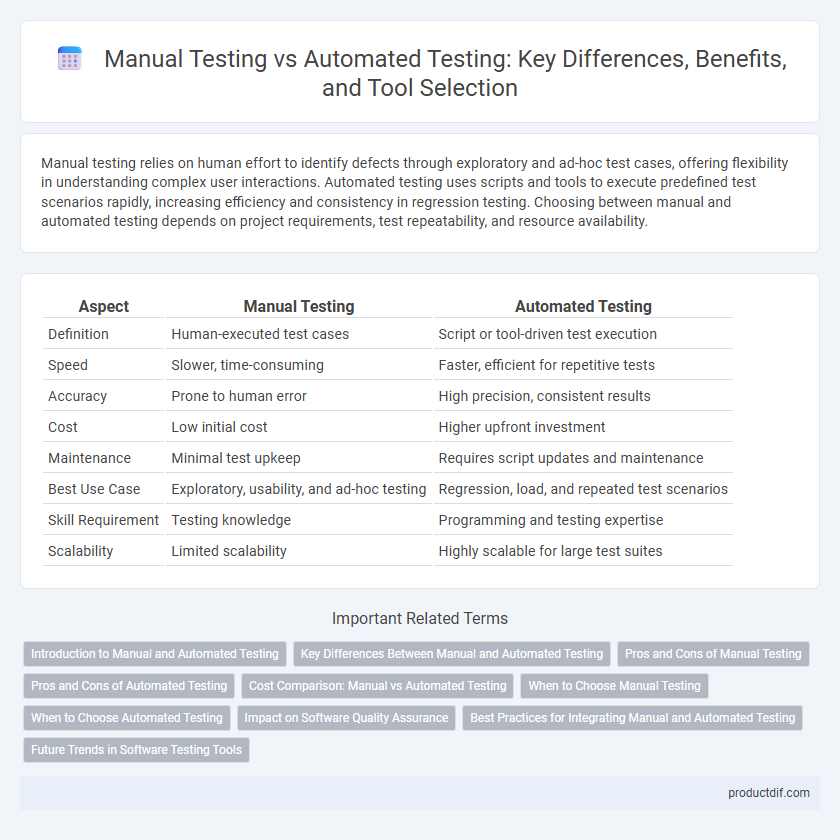Manual testing relies on human effort to identify defects through exploratory and ad-hoc test cases, offering flexibility in understanding complex user interactions. Automated testing uses scripts and tools to execute predefined test scenarios rapidly, increasing efficiency and consistency in regression testing. Choosing between manual and automated testing depends on project requirements, test repeatability, and resource availability.
Table of Comparison
| Aspect | Manual Testing | Automated Testing |
|---|---|---|
| Definition | Human-executed test cases | Script or tool-driven test execution |
| Speed | Slower, time-consuming | Faster, efficient for repetitive tests |
| Accuracy | Prone to human error | High precision, consistent results |
| Cost | Low initial cost | Higher upfront investment |
| Maintenance | Minimal test upkeep | Requires script updates and maintenance |
| Best Use Case | Exploratory, usability, and ad-hoc testing | Regression, load, and repeated test scenarios |
| Skill Requirement | Testing knowledge | Programming and testing expertise |
| Scalability | Limited scalability | Highly scalable for large test suites |
Introduction to Manual and Automated Testing
Manual testing involves human testers executing test cases without the use of scripts or automation tools, allowing for exploratory, usability, and ad-hoc testing. Automated testing uses specialized software tools to run pre-scripted tests on applications, enabling faster execution, repeatability, and integration into continuous integration/continuous deployment (CI/CD) pipelines. Both approaches play crucial roles in quality assurance, with manual testing providing human insight and automated testing offering efficiency and scalability.
Key Differences Between Manual and Automated Testing
Manual testing involves human testers executing test cases without the use of automation tools, allowing for exploratory and usability testing that adapts to dynamic user behavior. Automated testing utilizes scripts and software tools to perform repetitive and regression tests rapidly, increasing test coverage and consistency while reducing human error. Key differences include execution speed, repeatability, accuracy, cost efficiency over time, and the suitability for complex scenarios versus high-volume test cases.
Pros and Cons of Manual Testing
Manual testing offers the advantage of human intuition and exploratory skills, allowing testers to identify unexpected issues through subjective judgment and usability feedback. It is cost-effective for small projects and early development stages but can be time-consuming and prone to human error, limiting scalability for repetitive tasks. Manual testing lacks the efficiency and speed of automated testing, making it less suitable for regression tests or large-scale test suites requiring frequent execution.
Pros and Cons of Automated Testing
Automated testing offers significant advantages such as faster execution, higher accuracy, and the ability to run repetitive tests consistently without human error, making it ideal for regression and load testing. However, it requires substantial initial investment in scripting and maintenance, and is less effective for exploratory, usability, or ad-hoc testing where human judgment is crucial. The scalability and reliability of automated testing tools like Selenium, JUnit, and TestComplete enable continuous integration and delivery pipelines to improve software quality and reduce time to market.
Cost Comparison: Manual vs Automated Testing
Manual testing generally incurs higher labor costs due to the time-intensive nature of executing repetitive test cases, especially in large-scale projects. Automated testing requires an initial investment in tools and script development, but offers significant cost savings over time by enabling faster test execution and reducing human error. Organizations can achieve lower overall testing expenses by balancing manual efforts for exploratory scenarios with automated scripts for regression and performance testing.
When to Choose Manual Testing
Manual testing is preferred when dealing with exploratory, usability, or ad-hoc testing scenarios where human judgment and intuition are critical. It is ideal for verifying user interface elements, user experience flows, and detecting visual or design inconsistencies that automated scripts might miss. Manual testing is essential for early-stage projects with frequently changing requirements, where automation scripts may need constant updates.
When to Choose Automated Testing
Automated testing is ideal for repetitive, large-scale test cases requiring fast execution and consistent accuracy, such as regression testing and load testing. It significantly reduces human error and accelerates feedback loops in continuous integration and deployment pipelines. Organizations adopt automated testing when aiming to increase test coverage and efficiency in agile development environments.
Impact on Software Quality Assurance
Manual testing enables detailed exploratory assessments and usability evaluations, detecting subtle user experience issues often missed by automated tools. Automated testing accelerates regression checks and ensures consistent execution of repetitive test cases, significantly reducing human error and increasing test coverage. Combining both approaches enhances software quality assurance by balancing thoroughness with efficiency, leading to more reliable and robust software releases.
Best Practices for Integrating Manual and Automated Testing
Effective integration of manual and automated testing involves identifying test cases best suited for automation, such as repetitive or regression tests, while reserving exploratory, usability, and ad-hoc scenarios for manual testing. Establishing a continuous testing framework with seamless communication between manual testers and automation engineers enhances test coverage and defect detection. Regularly updating automated scripts based on manual test insights ensures adaptability to changing requirements and accelerates development cycles.
Future Trends in Software Testing Tools
Future trends in software testing tools emphasize the integration of AI and machine learning to enhance both manual and automated testing processes. Automated testing tools are advancing with capabilities like self-healing scripts and predictive analytics, which reduce maintenance efforts and improve test accuracy. Manual testing remains vital for exploratory and usability testing, supported by AI-driven tools that provide smarter test case recommendations and real-time feedback to testers.
Manual testing vs Automated testing Infographic

 productdif.com
productdif.com